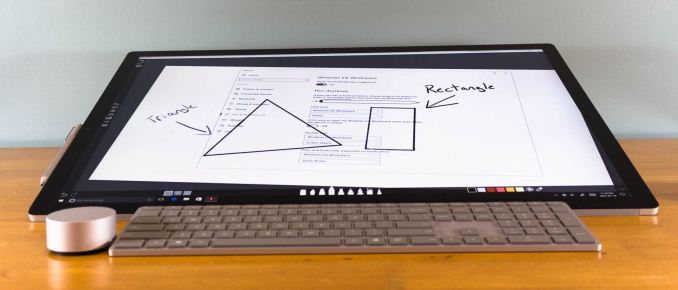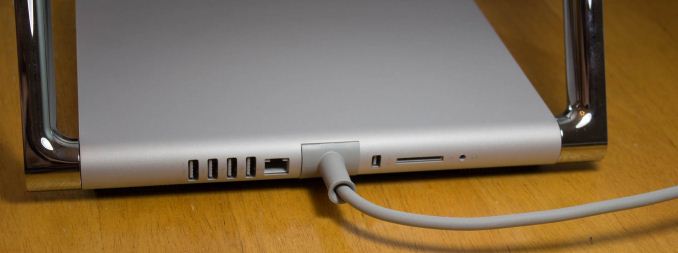The Microsoft Surface Studio Review
by Brett Howse on January 20, 2017 8:00 AM EST- Posted in
- Desktop
- Microsoft
- Surface
- Surface Studio
Design and the Zero-Gravity Hinge
Microsoft has built a brand around Surface, and that’s not an easy thing to accomplish. The Surface Studio fits in very well with the design ethos of the rest of the Surface lineup, and there has been quite a bit of attention to details paid in the creation of their first desktop computer. The first, and most obvious, is the finish, which matches perfectly with the other Surface devices, despite being made from aluminum rather than the magnesium alloy used on the portable products.
The 3:2 aspect ratio of the Surface Studio display is now a hallmark of the Surface brand (outside of Surface Hub), and having a taller display makes doing most tasks on a desktop a more pleasant experience. The increased surface area can’t be forgotten either, with the Surface Studio offering 17% more screen real estate than what's arguably the Studio's closest competitor, the 27-inch iMac, which amounts to an additional 54 square inches of display. Widescreen at 16:9 has never been a great aspect ratio for PC tasks, but the proliferation of high definition television seems to have moved the entire industry this way in an effort to save costs. When looking at the price of the Surface Studio, it’s important to remember that the entire display industry has moved to 16:9 as a standard, which impacts the entire supply chain and tooling required. Moving to an aspect ratio outside of 16:9 has large cost implications, but the end results are certainly worth it. Hopefully we will see a few other manufacturers use this as a means to source displays like this, much like the Surface Pro 3 and Pro 4 have ushered in more 3:2 devices at that much smaller size. And speaking of attention to detail, the Surface Studio is actually 28.125-inches diagonal, and as we'll see in a bit, that last 0.125-inches is very important.
It seems with Surface, Microsoft always wants to have a trick up their sleeve. With the original Surface RT and Surface Pro, it was the kickstand, which has been adopted by quite a few manufacturers for their own device since it works so well. When they launched their first laptop, the Surface Book, it was the muscle wire locking mechanism to remove the display from the base, as well as the dynamic fulcrum hinge to make the top-heavy laptop more stable. With the Surface Studio, the zero-gravity hinge is most definitely its signature design feature.
With two chrome arms flanking the base, the Surface Studio can almost effortlessly be folded down into a drafting table. The hinge mechanism provides a perfect counterbalance to the weight of the display, making it feel like it has almost no weight at all. The hinge is a single movement as well, so you don’t tip and fold the screen, but instead folding the screen also causes it to move down. While this does limit the functionality somewhat – for instance, you can't move the screen half way down and then fold it up straight again – the result is truly a wonderful design which almost needs to be seen in person.
Because you can’t tip the screen without folding it, once you stop at any angle, the screen is very solid to work with, although it is the most secure when folded all the way down to the 20° angle. You would think a large desktop display would not be ideal to use with touch, but the Surface Studio zero-gravity hinge invites you to be more interactive with it, by keeping the display close and folding it down when needed. More traditional all-in-one computers with a touch screen are nowhere near as easy to work with, since holding your arm in dead-air can be tiring, but the folded display doesn’t suffer from these burdens.
The PC base also exudes Surface quality, with the signature color, and cooling vents all the way around in the same fashion as the Surface Pro and Surface Book. The PC base can be disassembled from the bottom if required, for access to the storage and fans, but the remainder of the system is soldered to the board as you would expect in a small form factor device like this. The most frustrating part of the Surface Studio base is that all the inputs and outputs are on the rear of the device, so connecting something over USB, or inserting a SD card into the PC, is not as simple as it should be. This is a form over function decision, and it would be nice to see some of the ports offered at least on the side of the base to make it a bit easier to access.
The desktop PC market has not been as exciting to watch as the smaller and more portable laptops and tablets, but the Surface Studio sets a new high mark for desktop PC design and looks. Some of the decisions are form over function, but the majority of the design decisions actually improve the user experience. The zero-gravity hinge is a masterpiece of engineering, with such a smooth action that it really does feel like the display has no mass at all.













197 Comments
View All Comments
nerd1 - Sunday, January 22, 2017 - link
And for remaining $1500, I can build a nice, silent watercooled system with 1080 GPU at least.fanofanand - Monday, January 23, 2017 - link
Because then they couldn't milk you dry. If they sold this for $1500, who in their right mind would buy the full kit for $4k when they could add it to a $1500 machine that would mop the floor with this? Duh, because profits!BillBear - Sunday, January 22, 2017 - link
This isn't being priced as a tool for home. It's being priced as a professional tool for artists.When professional artists draw, they want to be able to taper the thickness of a line based on how much pressure they put on the stylus.
Surface Studio is just not sensitive enough to get a smoothly tapering line, especially towards the bottom of the scale. This is not a problem you have with Wacom's products.
Ro_Ja - Monday, January 23, 2017 - link
Could've used a GTX 1060 for the base model, a 1070 on the next one and a 1080 for the high end variant.Thorin.2604 - Monday, January 23, 2017 - link
you need to hackint0sh it - to get a decent Designdesktophasseb64 - Monday, January 23, 2017 - link
ohh my!! Reading first page--> price tag and that small SSD!! Hybrid drive??? 2017!!haha!! End of reading
phexac - Tuesday, January 24, 2017 - link
One thing this review doesn't mention is smoothness of the interface. I played around with a base model of this at the MSFT store. While I cannot say what the models with higher end GPUs would perform like, the model that I used was severeky handicapped by the GPU. Just moving windows around the screen was super jaggy. IMO, smooth performance is key to a machine like that. This is something Apple understands with its devices, both mobile and Macs.MSFT creates a PC based on a gorgeous high definition screen and then handicaps it with an inadequate GPU. It's the eMachines all over again with wildly mismatched compents and crimped by too little RAM, too weak GPU and a horrid hard drive. Unlike eMachines, this doesn't sell at bargain prices.
This alone to make this product a non-starter. You MUST have smoother experience on a computer such as this.
bogda - Wednesday, January 25, 2017 - link
It all looks very impressive but shelling out 4.200$+tax and still ending up with only 128GB SSD cache/storage is simply wrong in my opinion.I am OK with Maxwell graphics since this is not gaming machine.
Ubercake - Wednesday, January 25, 2017 - link
I like Windows 10 and the Xbox One, but when it comes to hardware from Microsoft, especially with niche products, don't expect support for that many years.Examples, Surface RT, Band 1, Band 2, Zune Player. Also, consider little to no mainstream app support for Windows phones. I'm sure there are more examples people can come up with.
jackpro - Thursday, January 26, 2017 - link
Would like to have read on tge pen performance